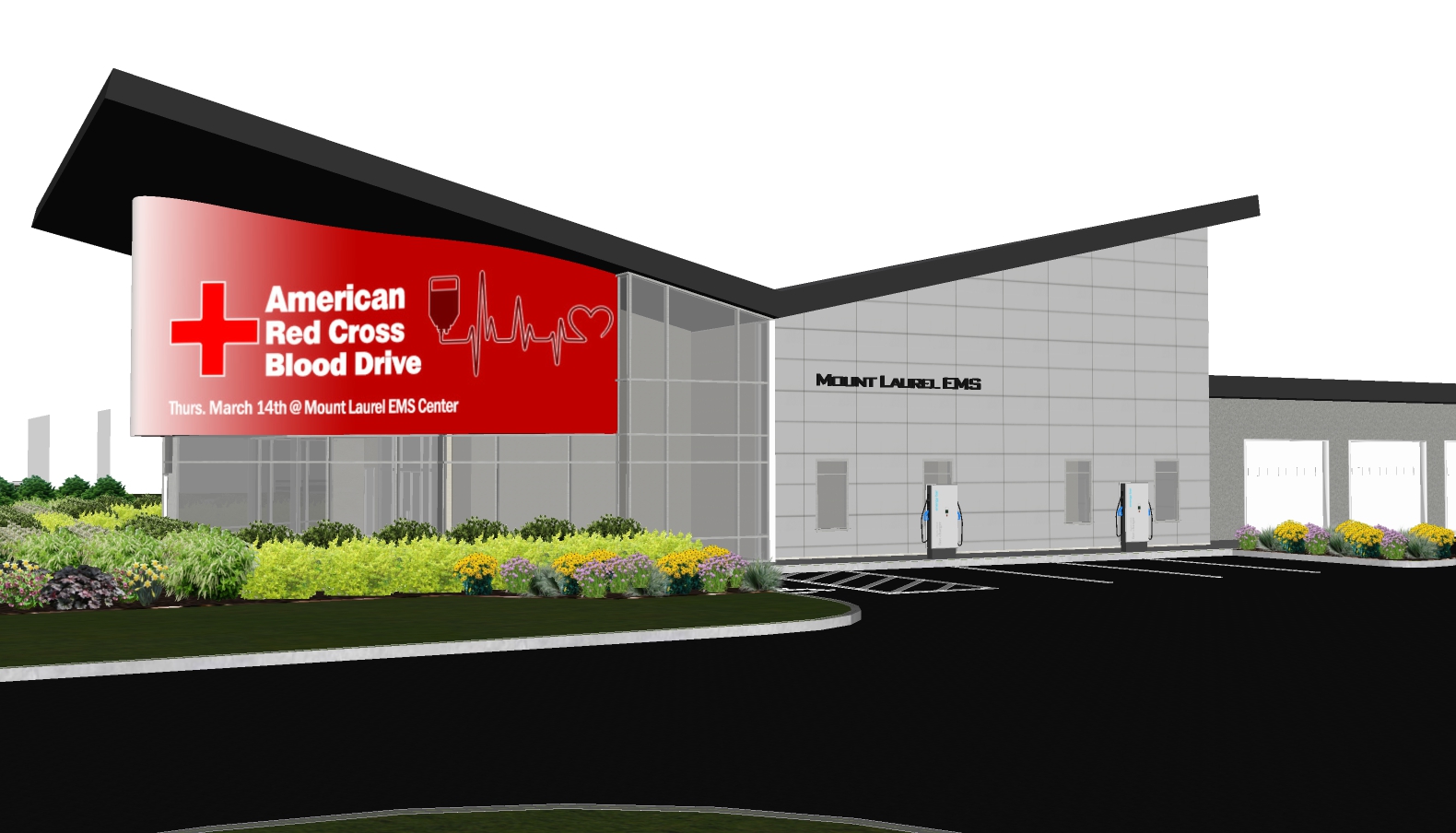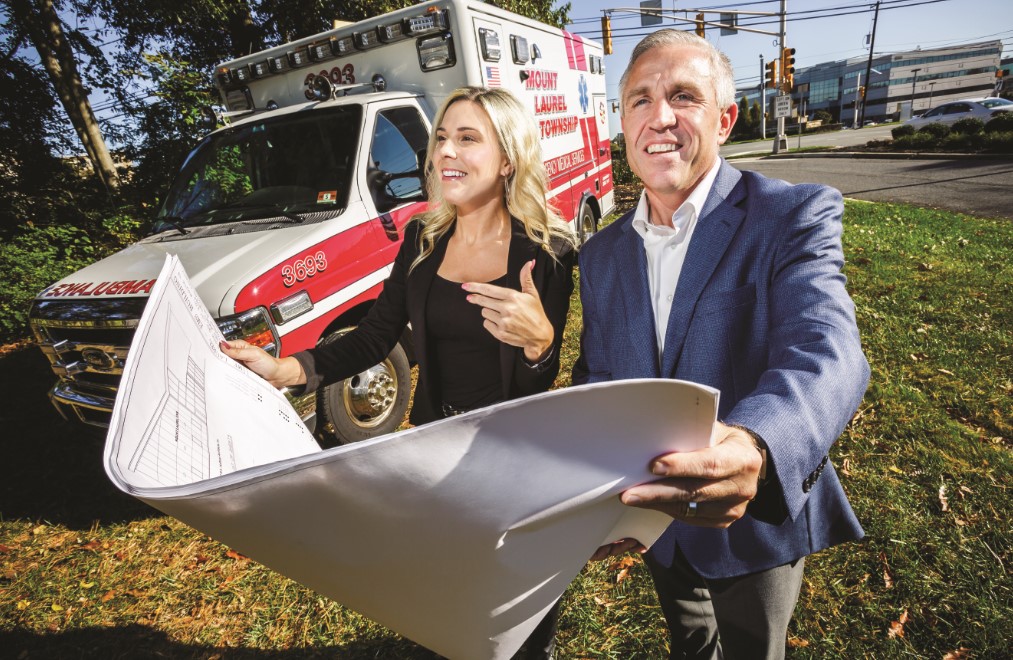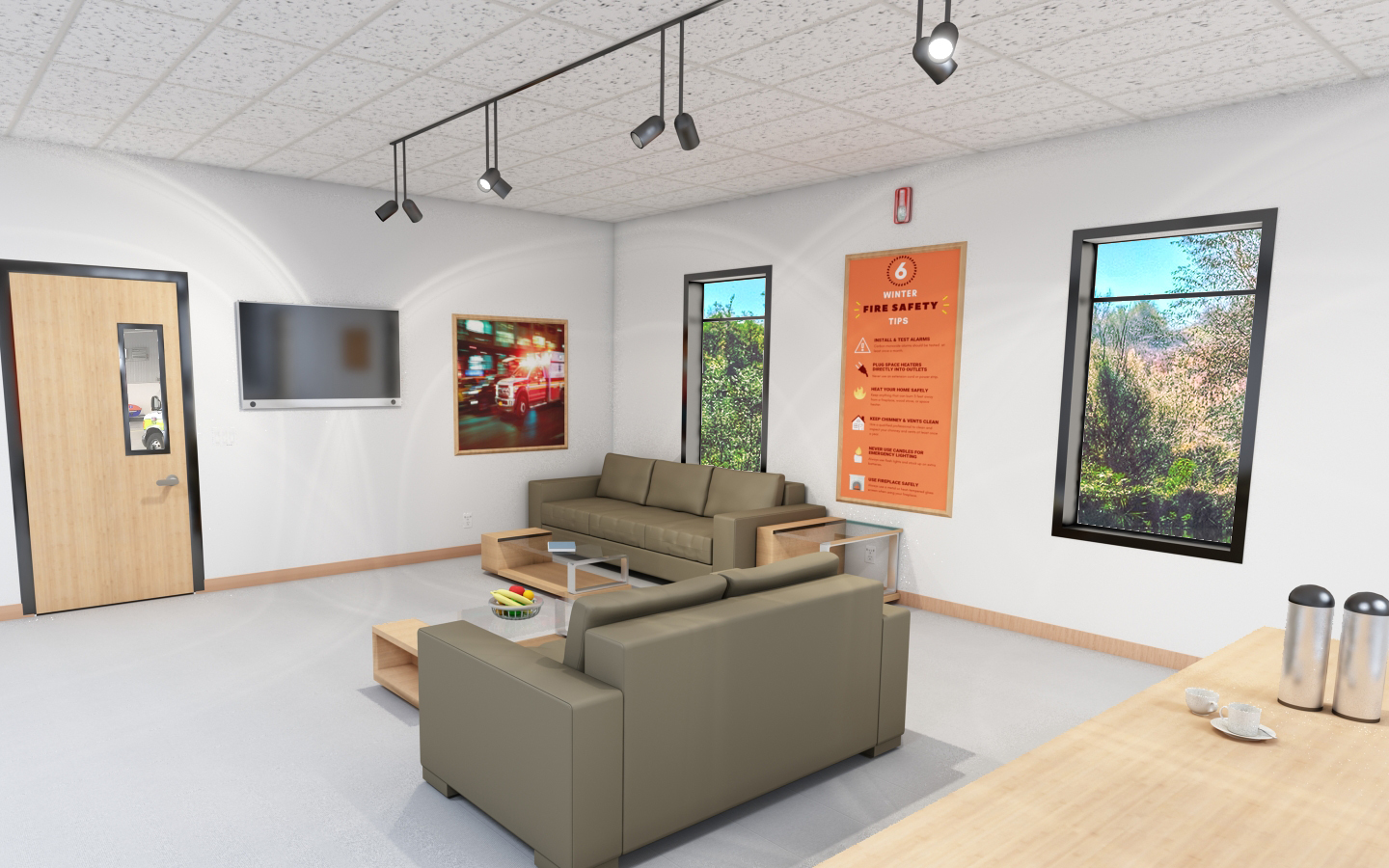ADVERTISEMENT
The New Station Model With a Message
The price of building an EMS station can vary greatly based upon location and size, but it’s a costly undertaking for any community. According to Tim Earle, executive vice president of investment for Pennsylvania-based design firm Catalyst Experiential, a typical EMS facility is 5,000–8,000 square feet, and the cost of building and fitting it out can easily exceed $2.5 million.
In addition to the cost of construction is the expense of acquiring the land and site development, assuming a suitable parcel is not already owned. A central location is ideal, but coverage area and response time are most important, which requires finding land adjacent to major roadways that provide quick access to as many people as possible.
Unfortunately, land along such arteries is expensive, and a one-acre parcel adds at least $500,000 to the cost. Site development, including clearing, moving soil, stormwater management, parking, utility connections, and site lighting, can add another $400,000–$600,000. Start to add additional features, and the bottom line easily approaches $4 million.
For most municipalities this level of cost means the need for a new EMS station must be balanced with budgetary considerations and competing priorities. Mount Laurel, N.J., came up with a forward-thinking way to solve this conundrum, developing a state-of-the-art EMS facility that will not cost taxpayers a dime.
A Public-Private Partnership
The township of Mount Laurel already had an urgent need for a new EMS station on its radar in 2018 when Catalyst Experiential approached it to discuss possible public-private development projects. Catalyst works with municipalities to integrate visual communication technology into community assets such as landmarks, experiences (e.g., dog parks and amphitheaters), and infrastructure projects such as public-safety facilities. Advertising on the displays funds the projects, so there is no cost to the communities that benefit from them.
Mount Laurel’s biggest need was its new EMS facility. “EMS facilities are one of the products in our portfolio,” says Amanda Toton, the company’s vice president of development. “We were excited to work with the township to help them reach their goals.”
Catalyst asked the township and its EMS department to put together the top features they desired in a new station, and Catalyst began researching potential parcels where it could be built. Over the past decade, as the township had grown, so did its call volume, with more calls from farther away from Mount Laurel EMS’ existing station. The EMS team pinpointed spots where they’d answered calls over the past year, which was invaluable in identifying potential locations that would enable the fastest response times for the most people.
Form Meets Function
The existing station, built in the 1990s, was inefficiently designed, and Mount Laurel needed a headquarters it could grow into, with a better distribution of square footage and more room for vehicles.
“At that point we hadn’t yet chosen a new location, but we had a good idea about what we wanted in a new station and where it might be,” says Chief Joseph Stringfellow, JD, EMT-B. “We knew we wanted it to be a place that would be comfortable for our crews when they were there for an extended period of time. And as we’d mapped out our service area, we wanted a location situated centrally near roads that would enable us to quickly get anywhere.”
EMS personnel drew up a wish list that anticipated increased call volume in the coming years. The list included four 45-foot heated bays with garage doors on both sides of the building and drive-through vehicle access. Drive-through bays are one of those details that can add cost, for additional doors and other construction, but with vehicular accidents among the leading causes of onsite work injuries for emergency personnel, their integration has become a best practice for avoiding incidents on the job. The Mount Laurel team therefore put this high on its priority list. In addition, the bays decrease response time, enabling crews to quickly enter or exit from either side of the building.
They also wanted the new building to include office space for training, two separate sleeping quarters (for males and females), locker rooms, two laundry rooms, a lounge, and a kitchen. There also had to be room for voting machines: As Mount Laurel’s population grew and required new polling locations, the new station would serve as one, accommodating machines in both the bays and training room. In addition, Catalyst included extra storage in the mechanical room, as it became clear during conversations with the EMS team that there is no such thing as too much storage.
In many instances wish lists conflict with budgetary realities, and departments and municipalities must negotiate priorities and compromises. In this case, Catalyst senior experiential designer Pete Henry notes, “We were able to satisfy everything on their list and then some. The result is a very engaging modern design in keeping with the vision of the township, tied to a very practical use case. Form blends with function in every aspect of the facility.”
Nailing the Details
While designing to the wish list created the most noticeable features, it was through the small details that the department was able to make sure the new facility really met its needs. These seemingly minor elements aren’t always anticipated up-front. They may not add a great deal of cost or effort if you plan for them but can be a pain in the neck if you need to retrofit later. For instance, “you can never have enough electrical outlets,” says Stringfellow. “Wherever people put in two, we want four. Same with Ethernet. Many offices only have one per outlet. Two reduces the need for a splitter if you have to connect multiple devices.”
Accordingly, Mount Laurel’s facility will include four outlets on key electrical boxes, and boxes will be included on the ceilings of the bays. The same approach will apply to Ethernet ports, with two ports where required. These are small details, but they make for a more efficient facility and reduce the need to have wires and cables running across rooms.
The team continued to work through details and practicalities as the designs were developed. Spacious lobbies are frequently requested in new public buildings, but the EMS team noted that EMS lobbies are rarely used and opted to decrease their lobby size to make room for additional storage.
One of the more interesting discussions revolved around laundry rooms. Deputy Chief John Hamilton noted the need for two laundry rooms in the new space: “One is for internal items, including laundry and personal effects. The other is for potentially contaminated items, and the two should never be mixed.”
The final design solves this by limiting access to each laundry room, with the door to the normal laundry room situated by the locker rooms and the door to the hazardous-waste room close to the vehicle bays, with no direct access from the living quarters. As Earle noted, “Changing where the door is now doesn’t cost a thing and makes life a lot easier down the road.”
The Ideal Location
The new location, situated across town from the old facility, will make use of an underdeveloped parcel of land on Route 73. On a visit to the site, Mayor Kurt Folcher points to weeds along the roadway. “This has been undeveloped for over a decade,” he says, “and we had our eyes on it for redevelopment. It’s a relief to the township that this area will be transformed into something needed that we can all be proud of.”
EMS facilities have large footprints, Toton notes, so the property required enough space as well as proper entrance and egress. Land with those characteristics has a high commercial value, which is why you sometimes see emergency facilities placed in less-busy locations, close to major highways but removed enough to not command a premium. In Catalyst’s model the busy location is a requirement because of the signage, so securing this property was a win for both the company and the township.
Nevertheless, the location presented some design challenges. For instance, because the topography of the site was higher in front and the building requires ADA compliance, Earle points out, the required entry-level ramps took extensive thought and planning.
The station’s architecture closely hews to the aesthetic and “visual language” of the municipality. It was important to Catalyst to create an architecturally significant design and not just a utilitarian shell. Like other nearby buildings on Route 73, it will have a curved front with curtain wall glass façade.
Visual Communications
A key feature that differentiates the station from the typical municipal building is the integration of visual communications technology into the façade.
“We’ve been pioneering the use of this technology in occupied structures,” Henry explains. “Our vision is to rethink what a sign is and, rather than create signs that interrupt the landscape, integrate signs with architecture and buildings for a cohesive and aesthetically pleasing experience.”
The latest-generation high-resolution surface-mount diode (SMD) screens can be camouflaged to match a building’s façade, making them completely undetectable until the display is turned on. They will be used for advertising, and the municipality has access to post its own announcements and events, as well as emergency alerts.
“Before we started this collaboration, I’d never seen that kind of technology before, and I think it’s a real asset to the project,” says Stringfellow. “We will definitely use it to get messages out to more people, whether it’s about a training session or CPR classes.”
The displays will also be used to recruit new volunteers, while the staff anticipates the state-of-the-art facility and amenities will help retain them.
As the initial ideas have become a design and then reality, it has been an exciting process for the entire Mount Laurel EMS team.
“I can’t wait until next summer, when the new station is completed,” says Hamilton, walking the location’s perimeter. “I never thought I would see this in my career.”
Sidebar: Going Green
As part of the design process, Catalyst and the municipality also talked about incorporating green elements and potentially taking advantage of the Sustainable Jersey municipal certification program, which awards points to municipalities toward certification in sustainability.
The highest level, silver, denotes statewide leadership in commitment to sustainability and increases municipal grant opportunities.
“We presented green options to them, and it encouraged some key stakeholders to get on board with the project,” says Toton. “By integrating these features, the township has the potential to earn more points toward certification.”
As such, the new 7,860-square foot “green-tech” station includes many environmentally friendly features, such as electric vehicle charging stations and solar roof panels.
Elisa Ludwig is an author and journalist who frequently writes about community matters and workplace trends. She has written five books and is a contributing writer to Risk and Insurance Magazine as well as several newspapers and educational publications.














Comments
It is nice to build the new facility. However the construction has taken too much time without any explanation to the community why there is a delay
As far as I am concerned it has been an eyesore for those of us who live in Rogerswalk. There has been no attempt to at least landscape it now the building is mostly completed and right now sitting there with no apparent construction taking place.
—Harris Leventhal